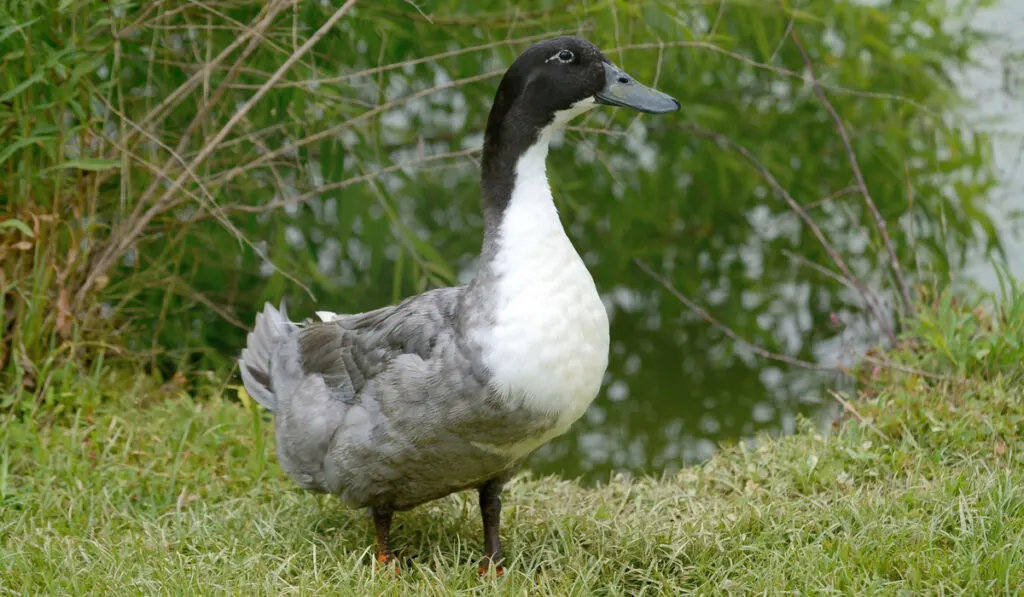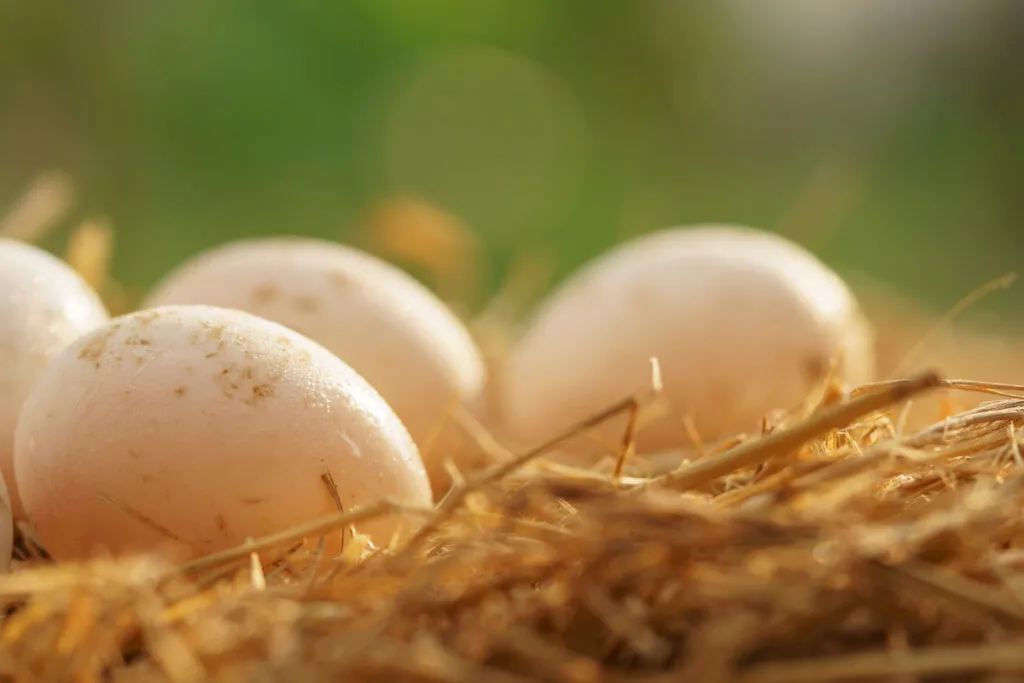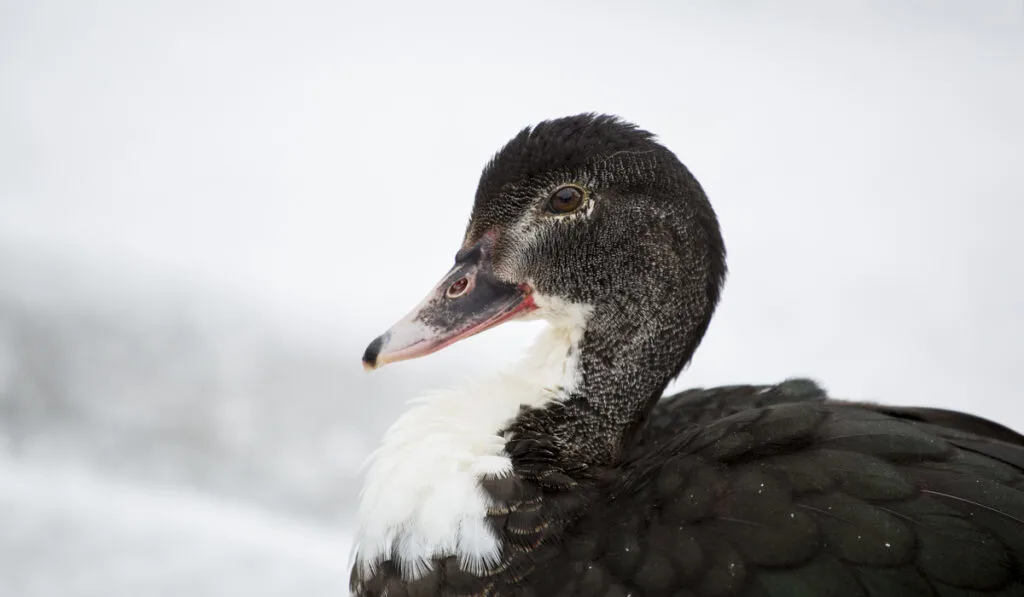Are you looking for a decent meat and egg producer to add to your utility flock? Or are you a beginner duck keeper looking for an easy-going breed to start out with?
Look no further than the Swedish Blue duck!
From decent production to aesthetics, minimal maintenance, and robustness, this duck breed will not disappoint, as you will see in this guide.
Table of Contents
History
The Swedish Blue duck, also known as the Blue Swedish, is a domesticated duck breed that was first developed by farmers in 1835 in Swedish Pomerania (now located in northeast Germany).
From there, the first Swedish Blue ducks were exported to North America, specifically the United States in 1884.
The American Poultry Association added Swedish Blue ducks to their Standard of Perfection in 1904.
The blue-colored ducks were traditionally revered for their incredible hardiness, superior meat production, and ability to evade predators.
Today, the Swedish Blue duck breed is raised for its meat and eggs, as a pet, or for ornamental purposes.

Appearance
Swedish Blue ducks are endowed with attractive color variations and are considered a medium-sized breed by the American Poultry Association.
Drakes boast greenish bills and dark brown eyes on their dark blue heads.
They have a bluish plumage that is perfectly contrasted by a white bib that runs from beneath the bill to midway down the breast.
Females, on the other hand, have grayish-blue bills, heads, and bodies. They also have the signature white bib that blends well with the rest of their plumage and runs from their neck to their breast.
Both sexes have reddish-brown shanks and feet with grayish-black markings. These ducks may also have white strokes on their outer wings.
Depending on the varieties bred, ducklings can have blue, black, silver, or splashed plumage.
Characteristics
Swedish Blue ducks are excellent foragers and do not appreciate being confined.
They are happy in enclosures and gardens as long as they can forage for bugs and other critters.
Though they love free ranging, consider providing Swedish Blues with a shelter where they can escape the elements and predators.
Also, easy access to clean water and food will help keep them content and healthy.
Size
Like Rouen ducks, Swedish Blue ducks are considered a medium-sized bird breed. The ducks can weigh between 6.5 to 8 pounds.
Mature drakes weigh 8 pounds, while females weigh 7 pounds.
Similarly, the standard weight for young males and females is 6.5 and 5 pounds, respectively.
Uses
As with other domesticated duck breeds, Swedish Blue ducks are primarily raised for their nutritious meat and eggs.
What’s more, their friendly and calm demeanor makes them ideal options for pets.
Alternatively, their attractive coloration makes Swedish Blues great ornamental birds for exhibitions.
Whatever your reasons for raising these ducks, you can never go wrong with Blue Swedish ducks due to their easy maintenance.

Egg Production
Like most duck breeds, Swedish Blue ducks are primarily raised for their egg production.
And while Swedish Blue hens are not prolific layers, they can produce an estimated 100 to 180 eggs annually.
The eggs are mostly white but can occasionally have green, blue, or gray tints and are large enough to weigh 2 to 3 ounces (65 to 90 grams) depending on their incubation stage.
Swedish Blue hens reach maturity and start laying eggs at the age of six months.
However, some don’t start laying until they are seven months old. After laying, the eggs have an incubation period of 28 days.
As far as nutritional value goes, Swedish Blue duck eggs are packed with minerals, vitamins, amino acids, and protein. They are also rich in fats and cholesterol, hence why they are considered more nutritious than chicken eggs.
Some of the other nutrients the eggs provide include:
- calories
- carbs
- selenium
- iron
- choline
As healthy and beneficial as Blue Swedish eggs are, be cautious when consuming them to avoid allergies and potential heart diseases. The eggs also increase the risk of illnesses like salmonellosis, especially in children.
Meat Production
While Swedish Blue ducks are not as large as other duck breeds kept for meat, they are decent meat producers upon reaching four months.
Swedish Blue ducks are renowned for their juicy and tender dark meat.
This is thanks to their foraging habits and the fact that they mature fairly slowly and thereby have flavorful meat.
Though quite fatty, Blue Swedish duck meat is packed with iron, protein, selenium, vitamin B, and omega fatty acids.
Whether you go for the popular and milder breast or the darker leg, thigh, liver, heart, or gizzard, you can rest assured of its nutritional benefits to your body.
Swedish Blue duck’s meat is best enjoyed dried and cooked at 165°F. This helps kill any harmful bacteria that could cause poisoning.
Similarly, remember to exercise appropriate hygiene measures when handling the meat to prevent contamination.
Varieties
Swedish Blue ducks do not breed true.
As a result, developing a real Blue Swedish is quite challenging. This has, therefore, resulted in several known varieties of the Blue Swedish.
This means that a breeding pair of Swedish Blue ducks will produce different varieties of the same breed:
- Half of the ducklings will be the true Swedish Blues.
- A quarter of the remainder will be Black Swedish ducklings (with black plumage and white chests).
- The remaining quarter will be Splashed White or Silver Swedish Ducks (light gray color).
On the contrary, breeding a pair of Black Swedish ducks will give you only Black Swedish ducklings.
Also, breeding Silver or Splashed Swedish ducks with Black Swedish ducks will produce only true Blue Swedish ducklings.

Temperament
Though a bit shy, Swedish blue ducks are generally friendly and calm and will seamlessly blend with your existing flock. Their calm temperament makes them an ideal pet option for individuals and families.
It also makes them an ideal breed to ease beginners into duck keeping.
Keep in mind that like other animals, Blue Swedish ducks can be territorial during mating season.
Lifespan
The Swedish Blue ducks are among the hardiest bird breeds available today.
They have a lifespan of between 8 and 12 years, depending on how well you take care of them, as far as nutrition, shelter, and protection go.
Unfortunately, the American Livestock Breeds Conservancy has the Blue Swedish duck breed on the “watch list” since it is an endangered species with fewer numbers today than before.
That said, farmers must take intentional measures to help the breed recover its numbers. This can be done through the following measures:
- Providing high-quality feeds to supplement the birds’ foraging diet
- Offering proper housing to shield the birds from the elements
- Ensuring safe free ranging to protect the birds from predators

Sexing
Distinguishing between Swedish Blue drakes and hens is quite simple thanks to their unique differences.
For instance, Swedish Blue hens have bluish-slate bills, while drake bills are usually greenish blue.
What’s more, male Swedish ducks are larger than their female counterparts.
Generally, Blue Swedish ducks weigh between 6.5 and 8 pounds. However, an adult drake will weigh 8 pounds, while adult females weigh around 7 pounds.
Noise Levels
Blue Swedish ducks are a generally noisy breed.
Noise levels are another great way to differentiate between Blue Swedish males and females.
The hens have a loud yell in their quack. Drakes, on the other hand, have a low-pitched quack but can raise the pitch of their quack to match the hens.
Shelter
Blue Swedish ducks prefer spending time under foliage in enclosures like orchards.
That said, shelters like sheds and coops are vital for shielding the birds from the elements during bad weather.
Be sure to create a cool and shady environment when building shelters for your ducks.
This helps mimic the original natural climate of where the ducks were first developed.
As is the case with many duck breeds, your Swedish Blue ducks will appreciate having a pond in their shelter to cool down and swim in, as they would in their natural environment.
As far as ducklings go, housing them in a separate brooder will help prevent injuries as well as diseases.
A brooder is also a great way to ensure that the ducklings consume the right feed for proper development.

Nutrition
As we have already established, Swedish Blue ducks are excellent foragers that prefer free ranging over confinement.
As such, the birds meet a large part of their dietary needs with the insects and other foods that they forage.
That said, it is important to offer specialized dry feed to your ducks to ensure that you make up for any deficits in their foraged food.
Similarly, consider supplementing your ducks’ dry feed with:
- Worms
- Insects
- Seeds
- Vegetables
These make healthy supplements, especially if you do not have enough roaming ground for your ducks.
Keep in mind that ducklings should only consume chick starter feed since their dietary needs are different from adult ducks.
Needless to say, ensure that your flock always has access to fresh and clean water at all times, especially during the hotter months of the year.
Companionship
While Swedish Blue ducks make excellent pets, the birds are less stressed when they are part of a flock or have company.
Therefore, it will help to keep them in pairs, especially if you are raising them as pets.

Common Health Issues
Unlike with most livestock, it is quite challenging to tell when your ducks are ill.
This, therefore, requires owners to pay close attention even to hardy birds like the Swedish Blue ducks to catch any signs of illness.
Doing this allows you to catch diseases before they are too far gone and before they spread within your flock.
Here are some of the common health issues your Swedish Blue flock may be prone to:
| Disease | Causes | Symptoms |
| Bumblefoot | Bacterial infection | Painful abscess on feet Difficulty walking |
| Botulism | Bacterial infection (Clostridium botulinum) | Floppiness Muscle weakness Hunched posture |
| Aspergillosis | Fungal infection | Respiratory difficulty Tail bobbing weight loss |
| Avian influenza | Viral infection | Lack of energy Reduced egg production Swelling Diarrhea Nasal discharge |
| Fowl cholera | Bacterial infection (Pasteurella multocida) | Listlessness Shivering and huddling Respiratory sound Sneezing Sticky nasal discharge |
| Egg binding | Tail bobbing Mucus discharge | |
| Newcastle disease | Viral infection (Para-myxo) | Greenish diarrhea Sneezing Coughing Nasal discharge Muscular tremors |
| Arthritis | Infection, degeneration, or trauma | Lameness Lethargy Stiffness Reduced movement |
Final Thoughts
There you have it. As you can see from this guide, you can never go wrong with the Swedish Blue duck breed!
From consistent egg production to a friendly disposition and succulent meat production, the Blue Swedish duck is every farmer’s dream.
However, as attractive as the birds are, it will help to evaluate how much noise you can tolerate, especially if you have neighbors close by, before adding them to your flock.
Resources
- https://www.metzerfarms.com/bumblefoot.html#
- https://nt.gov.au/__data/assets/pdf_file/0010/233569/botulism-in-chickens-ducks-and-others.pdf
- https://vcahospitals.com/know-your-pet/aspergillosis-in-birds#:~:text=Aspergillosis
- http://www.duckdvm.com/condition/aspergillosis
- https://www.cdc.gov/flu/avianflu/avian-in-birds.htm
- https://www.michigan.gov/dnr/managing-resources/wildlife/wildlife-disease/fowl-cholera#:~:text=Fowl
- https://runnerduck.net/egg-problems.php#:~:text=Egg
- https://www.gov.scot/publications/newcastle-disease/#:~:text=Newcastle
- http://www.duckdvm.com/condition/arthritis
- https://learnpoultry.com/blue-swedish-duck/
- https://www.thehappychickencoop.com/blue-swedish-duck/
- https://en.wikipedia.org/wiki/Swedish_Blue
- https://petkeen.com/swedish-blue-duck/
- https://livestockconservancy.org/heritage-breeds/heritage-breeds-list/swedish-duck/
- https://www.purelypoultry.com/blue-swedish-ducklings-p-861.html
- https://beautyofbirds.com/blueswedishducks/
- https://www.roysfarm.com/swedish-blue-duck/
- https://www.osha.gov/sites/default/files/publications/avian_flu_animal_handlers.pdf
